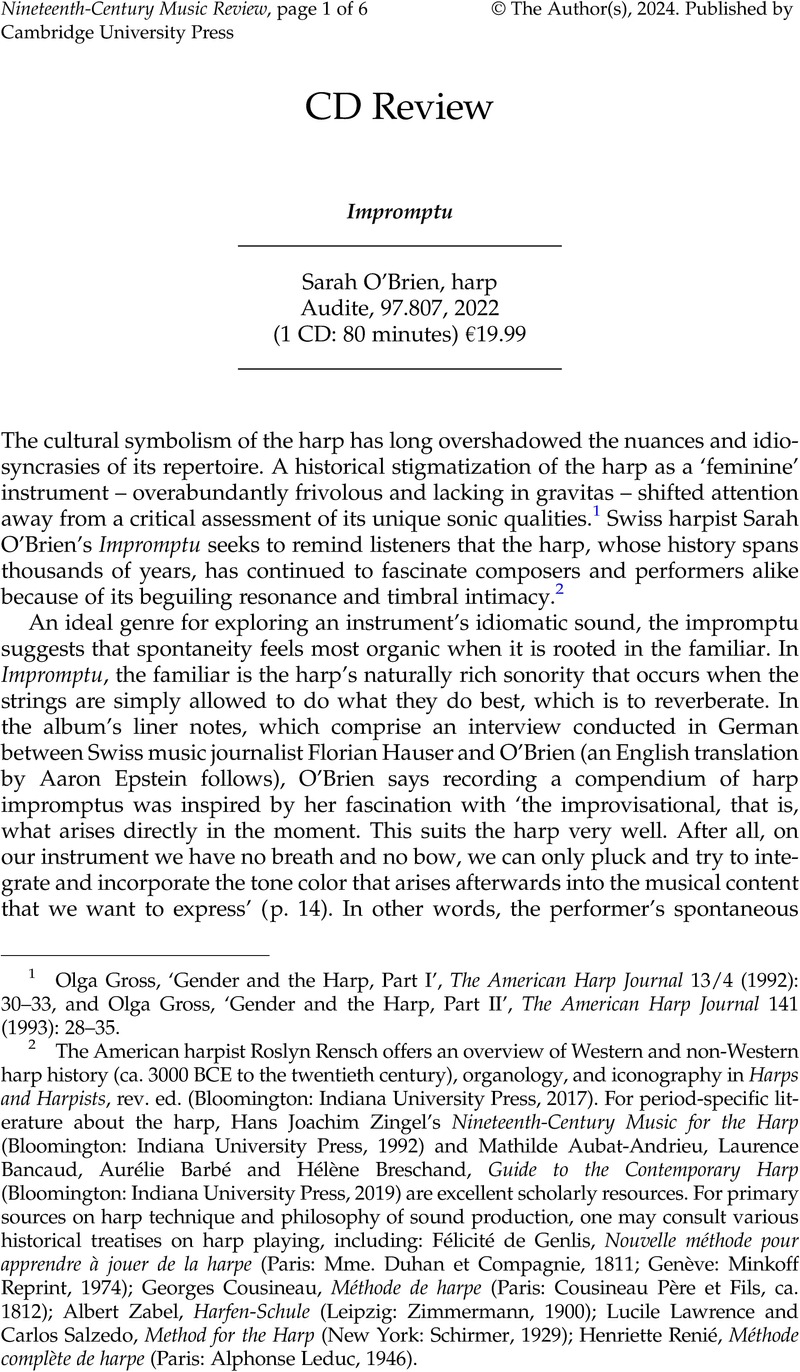No CrossRef data available.
Article contents
Impromptu Sarah O'Brien, harp Audite, 97.807, 2022 (1 CD: 80 minutes) €19.99
Review products
Published online by Cambridge University Press: 05 February 2024
Abstract

- Type
- CD Review
- Information
- Copyright
- Copyright © The Author(s), 2024. Published by Cambridge University Press
References
1 Gross, Olga, ‘Gender and the Harp, Part I’, The American Harp Journal 13/4 (1992): 30–33Google Scholar, and Gross, Olga, ‘Gender and the Harp, Part II’, The American Harp Journal 141 (1993): 28–35Google Scholar.
2 The American harpist Roslyn Rensch offers an overview of Western and non-Western harp history (ca. 3000 BCE to the twentieth century), organology, and iconography in Harps and Harpists, rev. ed. (Bloomington: Indiana University Press, 2017). For period-specific literature about the harp, Zingel's, Hans Joachim Nineteenth-Century Music for the Harp (Bloomington: Indiana University Press, 1992)Google Scholar and Aubat-Andrieu, Mathilde, Bancaud, Laurence, Barbé, Aurélie and Breschand, Hélène, Guide to the Contemporary Harp (Bloomington: Indiana University Press, 2019)CrossRefGoogle Scholar are excellent scholarly resources. For primary sources on harp technique and philosophy of sound production, one may consult various historical treatises on harp playing, including: de Genlis, Félicité, Nouvelle méthode pour apprendre à jouer de la harpe (Paris: Mme. Duhan et Compagnie, 1811; Genève: Minkoff Reprint, 1974)Google Scholar; Cousineau, Georges, Méthode de harpe (Paris: Cousineau Père et Fils, ca. 1812)Google Scholar; Zabel, Albert, Harfen-Schule (Leipzig: Zimmermann, 1900)Google Scholar; Lawrence, Lucile and Salzedo, Carlos, Method for the Harp (New York: Schirmer, 1929)Google Scholar; Renié, Henriette, Méthode complète de harpe (Paris: Alphonse Leduc, 1946)Google Scholar.
3 Swanson, Carl, ‘Who Actually Wrote the Impromptu of Fauré?’, The American Harp Journal 17/2 (1999): 39–41Google Scholar.
4 It may be helpful to know that O'Brien has studied with the French harpist Pierre Jamet, who was a student of Alphonse Hasselmans at the Paris Conservatory and thus, her technique, which produces a round, supple sound, is well-suited to works directly associated with the Paris Conservatory harp exams (e.g., Pierné's and Fauré's impromptus) or by French composers throughout the nineteenth and twentieth centuries. In the classical harp tradition, distinct pedagogical schools emerged in the nineteenth century, due to increased adoption of the double-action pedal harp by virtuoso harpists in the UK (Wales), France, Germany, and Russia (by way of Germany). However, most nineteenth-century repertoire for harp was composed by harpists, and thus, much of it is highly virtuosic and idiomatically written – what harpists consider to be prototypical Romantic harp technique. In the twentieth century, 1) more non-harpist composers (collaborating with harpists) began writing for the harp, which was influential in expanding, not changing per se, its techniques, and 2) the French-American harpist Carlos Salzedo (1885–1961) codified a new approach to harp technique, aesthetics, and composition. Salzedo, who was inspired by the mannered style of Russian dancer and choreographer Vaslav Nijinsky, created a technical methodology grounded in modernist philosophies and was explicitly trying to distance the harp from the (French) Romantic style; however, Salzedo's method is practised most in Anglophone North America and significantly less so in Europe. For more, see the sources by Rensch and Lawrence/Salzedo cited in footnote 2.
5 The modern pedal harp uses a double-action mechanism first patented by French harp-maker Sébastien Érard in 1810. However, the size of early nineteenth-century pedal harps was still smaller, with a narrower (straight) soundboard and range of 41 to 43 strings. By the late nineteenth century (c. 1880), the American harp manufacturer Lyon and Healy was producing pedal harps with forty-five strings. In 1895, Lyon and Healy patented the extended soundboard, an important development that improved volume of sound production on the harp. Most concert grand pedal harps (e.g., O'Brien's) now have a range of 47 strings and an extended soundboard. For more on the development of the modern harp, see Rensch, Harps and Harpists, chap. 8.
6 There are at least 20 other impromptus written for the harp that are not included on O'Brien's CD, most of which are relatively obscure because they are now rarely performed. Titled impromptus that fall within the long Romantic period include works for diatonic pedal harp by Charles Oberthür (1819–1895), John Thomas (1826–1913), Ferdinand Hummel (1855–1928), and Alfred Holý (1866–1948), and works for the chromatic harp – the cross-strung, pedal-less cousin of the diatonic harp popular during the late nineteenth and early twentieth centuries – by Henri Büsser (1872–1973) and Gabriel Grovlez (1879–1944).





